UC Blogs
Urban Homesteading Tour
Urban homesteading has been picking up speed, especially in the Bay Area, in the past few years. People, both young and old, are re-discovering skills once regarded as common knowledge by our grandparents and the generations before them. Skills such as tending a garden, growing edibles, cooking, keeping bees, raising animals (e.g., chickens and goats) cheese making, canning, preserving and fermenting foods from the garden, and basic carpentry, are all making a come-back. Indeed, urban homesteading has become so popular, that even mainstream corporate America has caught on. The posh San Francisco-based retailer, Williams-Sonoma, has even taken notice and developed their own line of homesteading products called “Agrarian” (I won’t go into it here, but that move has been met with controversy among urban homesteaders).
While there are a great number of resources on urban homesteading, for those starting out and wondering if this lifestyle is for them, the Institute on Urban Homesteading located in Oakland, California, is offering a (paid but affordable) tour of 7 different urban farms/gardens located at private residences in the East Bay on June 9, 2012 from 11 am - 5 pm. I had the pleasure of attending a tour of 3 urban farms last year to observe the creativity and ingenuity of people who squeeze utility out of every inch of their urban space to grow and raise their own food sustainably (see pictures below). Although utility tends to come first in managing an urban farm/garden, with beauty secondary, some of the urban farms on the tour were/are as beautiful as they were/are useful.
For more information, see http://iuhoakland.com/events.html .
Outstanding Entomologist
Ivana Li's fascinations with insects began in early childhood. She delighted in the insects on her parents' rose buses--the aphids, the ...
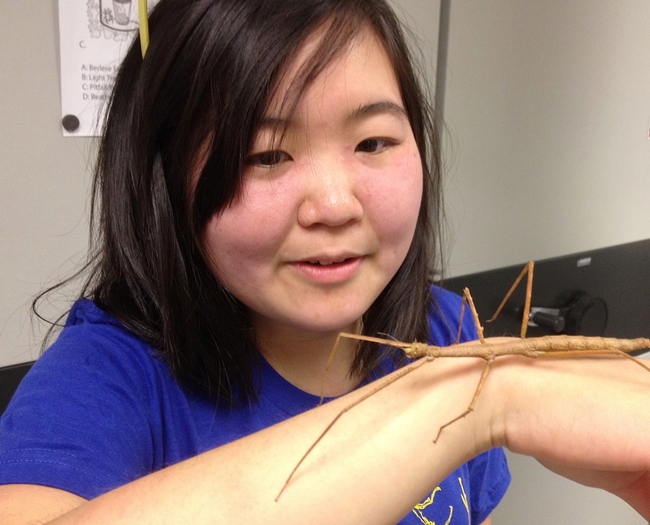
Ivana Li with a walking stick. (Photo by Fran Keller, Bohart Museum of Entomology)
Mystery Tree-Learning about an American Classic
My friends recently moved to a beautiful new country home, which sits on an acre of land with a creek. While walking in their yard, they pointed to a large tree about 25-30 feet tall and full of what looked like blackberries hanging from the tree. I’d never seen a tree full of blackberries. I looked expecting to see thorns and vines twisting among the branches but they were actually growing from the tree. My friend explained that the wild turkeys come and jump up to eat the berries, so they didn’t think the berries were poisonous. I took a few pictures and started my search…
It turns out that my friends have several mulberry trees in their yard. I’d often heard of fruitless mulberry trees, but I had never seen one with fruit. I discovered there are 150 different varieties of mulberry trees (Morus spp.) and many, many hybrids. The Red mulberry or American mulberry (M. rubra) is native in the eastern United States. The White mulberry (Morus alba) trees were originally imported from Asia during early colonial times because they are used to raise silk worms.
The mulberry tree is deciduous and often grown near the edge of open woodlands and near fresh water, which described the location on their property perfectly. The fruit is edible and is used for pies and jams because of its sweet and slightly tart flavor. The color of the actual fruit, does not determine the variety. The fruit can be white, pink, red and black but the fruit is really not a berry. It’s an aggregate fruit, which means it’s composed of lots of little berries stuck together, each with its own seed. The fruit is long and shaped similar to a blackberry, but hangs from a short, slender fruit stalk. The fruit is supposed to be delicious however; the color from the fruit is used as dyes so can easily stains things that the juices seeps into. That also including the droppings from birds when eat the berry, so the tree has a bad reputation among suburban homeowners.
After looking at the shape of the leaves, I believe that my friends have the Black mulberry (Morus nigra ) species that is native to southwestern Asia. It’s a beautiful full size tree in their large backyard. It’s in a great location. I think they will be gathering lots of delicious black mulberries for many years to come.
Here we go round the mulberry bush, the mulberry bush, the mulberry bush…here we go around the mulberry bush so early in the morning…
Sources:
http://www.crfg.org/pubs/ff/mulberry.html
http://en.wikipedia.org/wiki/Morus_nigra
http://www.pfaf.org/user/plant.aspx?latinname=Morus+nigra
http://www.ehow.com/how_5637978_make-mulberry-trees-produce-fruit.html
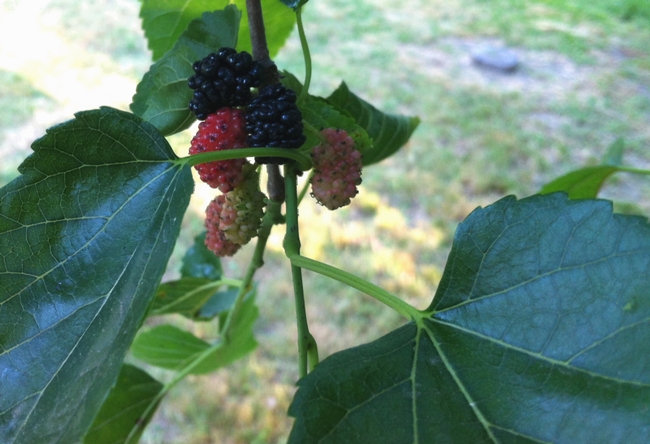
Mulberry fruit. (photos by Esther Blanco)
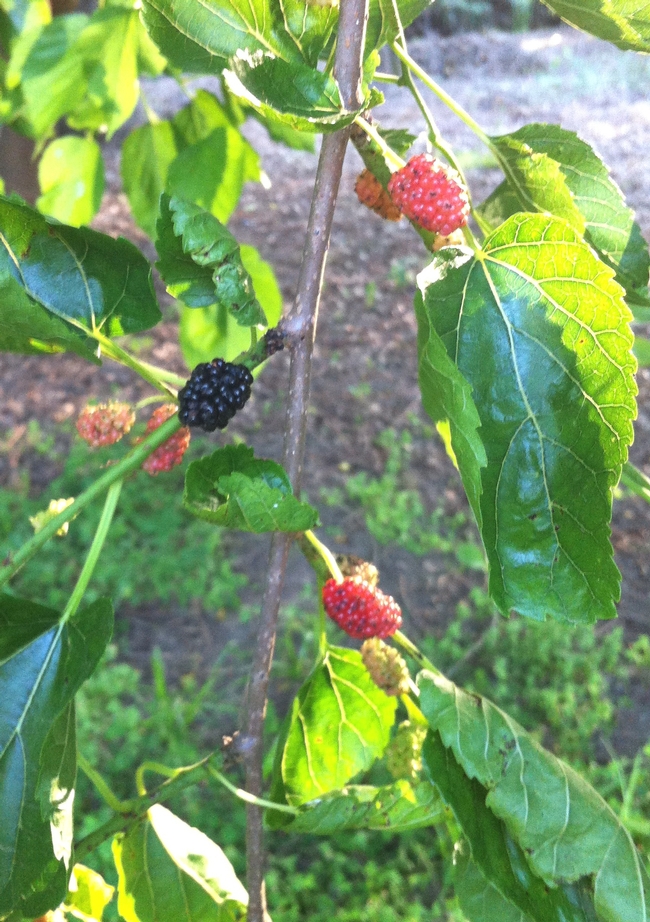
More fruit and leaves.
Scorpions!
Scorpions--to fear or to revere? The Bohart Museum of Entomology's open house last Sunday drew visitors of all ages who marveled at the scorpions...
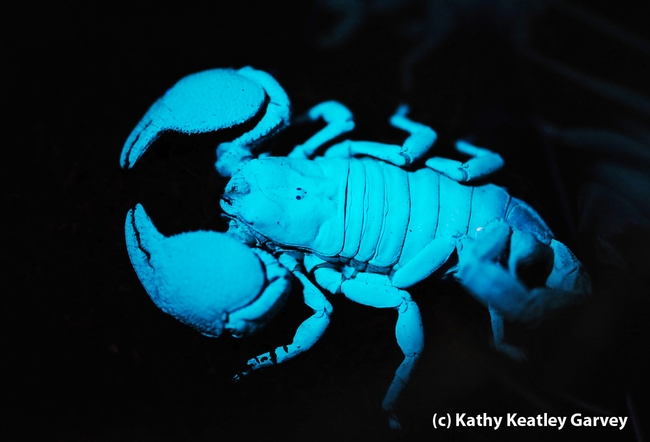
Scorpion glowing under ultraviolet light at the Bohart Museum of Entomology. (Photo by Kathy Keatley Garvey)
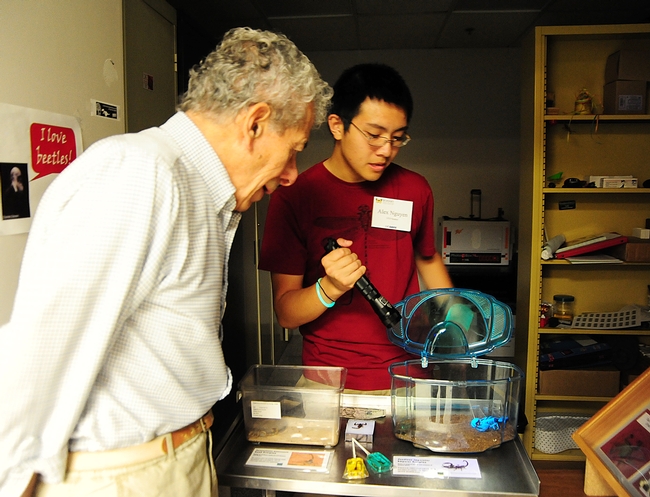
UC Davis entomology undergraduate student Alexander Nguyen flashes a UV light on a scorpion, as Professor Demosthenes Pappagianis, M.D., Ph.D., of Medical Microbiology and Immunology, watches. (Photo by Kathy Keatley Garvey)
Echeverias
Echeverias are some of my favorite succulents. I think I may be a collector. Their forms affect me in such a positive way. I do wish though, that more varieties were available in the U.S. I made the mistake of randomly searching on line for breath-taking specimens, only to find out later that they're only available in the U.K. or Australia. And they will not ship to me. Oddly enough though, in my random travels to the local big box stores, I find one or two of these hard to find plants for far cheaper. Wow that feels good. It's so strange that in such a fru-fru potentially high end collector's market, I get better results with random scavenging. Maybe I'll make my own hybrids.

